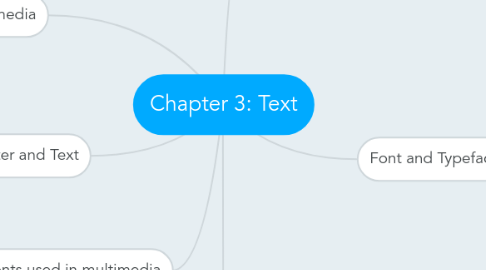Chapter 3: Text
von tnee jiehao


1. Text elements used in multimedia
1.1. 1.Menus for navigation 2.Interactive buttons 3.Fields for reading 4.HTML documents 5.Symbols and icons
2. Computer and Text
2.1. ASCII (American Standard Code for Information Interchange)
2.2. Extended Character Set (ISO Latin-1
2.3. Unicode
3. Hypermedia
3.1. -Hypermedia is not constrained to be text-based. -It can include other media, e.g., graphics, images, and especially the continuous media – sound and video.
3.2. Structure
3.2.1. 1.Links 2.Nodes 3.Anchors
4. Font and Typeface
4.1. Typeface
4.1.1. A typeface is a family of graphic characters, often with many type sizes and styles. Example : Bookman Old Style
4.2. Font
4.2.1. A font is a collection of characters of a single size and style belonging to a particular typeface family. Example : Arial 18 point Bold
4.3. Font styles
4.3.1. Boldface Italic Underlining Outlining
4.4. Font terminology
4.4.1. Baseline Cap height x-height Ascenders/descenders Kerning Tracking
5. Bitmap vs Vector
5.1. Bitmap
5.1.1. File size increases as more sizes are added. Require a lot of memory. Non-scalable.
5.2. Vector
5.2.1. File size is much smaller than bitmaps. TrueType, OpenType and PostScript are vector font formats.

